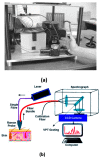Raman Spectroscopy of Carotenoid Compounds for Clinical Applications-A Review
- PMID: 36558154
- PMCID: PMC9784873
- DOI: 10.3390/molecules27249017
Raman Spectroscopy of Carotenoid Compounds for Clinical Applications-A Review
Abstract
Carotenoid compounds are ubiquitous in nature, providing the characteristic colouring of many algae, bacteria, fruits and vegetables. They are a critical component of the human diet and play a key role in human nutrition, health and disease. Therefore, the clinical importance of qualitative and quantitative carotene content analysis is increasingly recognised. In this review, the structural and optical properties of carotenoid compounds are reviewed, differentiating between those of carotenes and xanthophylls. The strong non-resonant and resonant Raman spectroscopic signatures of carotenoids are described, and advances in the use of Raman spectroscopy to identify carotenoids in biological environments are reviewed. Focus is drawn to applications in nutritional analysis, optometry and serology, based on in vitro and ex vivo measurements in skin, retina and blood, and progress towards establishing the technique in a clinical environment, as well as challenges and future perspectives, are explored.
Keywords: Raman spectroscopy; beta carotene; blood; carotenoids; lutein; lycopene; optometry; skin; zeaxanthin.
Conflict of interest statement
The authors declare no conflict of interest.
Figures






Similar articles
-
Lycopene and beta-carotene decompose more rapidly than lutein and zeaxanthin upon exposure to various pro-oxidants in vitro.Biofactors. 1999;10(2-3):105-13. doi: 10.1002/biof.5520100204. Biofactors. 1999. PMID: 10609870
-
Oxidation of carotenoids by heat and tobacco smoke.Biofactors. 2004;20(1):23-35. doi: 10.1002/biof.5520200103. Biofactors. 2004. PMID: 15096658
-
Configuration and dynamics of xanthophylls in light-harvesting antennae of higher plants. Spectroscopic analysis of isolated light-harvesting complex of photosystem II and thylakoid membranes.J Biol Chem. 2001 Jul 6;276(27):24862-70. doi: 10.1074/jbc.M103263200. Epub 2001 Apr 30. J Biol Chem. 2001. PMID: 11331293
-
Noninvasive detection of macular pigments in the human eye.J Biomed Opt. 2004 Jan-Feb;9(1):75-85. doi: 10.1117/1.1628240. J Biomed Opt. 2004. PMID: 14715058 Review.
-
Macular carotenoids: lutein and zeaxanthin.Dev Ophthalmol. 2005;38:70-88. doi: 10.1159/000082768. Dev Ophthalmol. 2005. PMID: 15604618 Review.
Cited by
-
Application of Micro- and Nano-Spectroscopic Techniques for Systematic Studies of Surface Features of the Barley Leaf Cuticle.ACS Omega. 2025 Jul 16;10(29):31428-31439. doi: 10.1021/acsomega.5c00744. eCollection 2025 Jul 29. ACS Omega. 2025. PMID: 40757344 Free PMC article.
-
Insights into the molecular basis of gastric mucosa as a first step for using Raman microscopy in paediatrics.Heliyon. 2024 Aug 14;10(16):e36231. doi: 10.1016/j.heliyon.2024.e36231. eCollection 2024 Aug 30. Heliyon. 2024. PMID: 39262989 Free PMC article.
-
Green Synthesis of CuO Nanoparticles-Structural, Morphological, and Dielectric Characterization.Materials (Basel). 2024 Nov 22;17(23):5709. doi: 10.3390/ma17235709. Materials (Basel). 2024. PMID: 39685144 Free PMC article.
-
Programmed cell death and redox metabolism protect Chlamydomonas reinhardtii populations from the galactic cosmic environment on the Artemis-1 mission.Sci Rep. 2025 Jul 2;15(1):23396. doi: 10.1038/s41598-025-05419-w. Sci Rep. 2025. PMID: 40603369 Free PMC article.
-
Raman spectroscopy on dried blood plasma allows diagnosis and monitoring of colorectal cancer.MedComm (2020). 2024 Oct 31;5(11):e774. doi: 10.1002/mco2.774. eCollection 2024 Nov. MedComm (2020). 2024. PMID: 39492836 Free PMC article.
References
-
- Damodaran S., Parkin K.L. Fennema’s Food Chemistry. 5th ed. CRC Press; Abingdon, UK: 2017.
-
- Lam T.K., Gallicchio L., Lindsley K., Shiels M., Hammond E., Tao X., Chen L., Robinson K.A., Caulfield L.E., Herman J.G., et al. Cruciferous Vegetable Consumption and Lung Cancer Risk: A Systematic Review. Cancer Epidemiol. Biomark. Prev. 2009;18:184–195. doi: 10.1158/1055-9965.EPI-08-0710. - DOI - PMC - PubMed
Publication types
MeSH terms
Substances
Grants and funding
LinkOut - more resources
Full Text Sources

